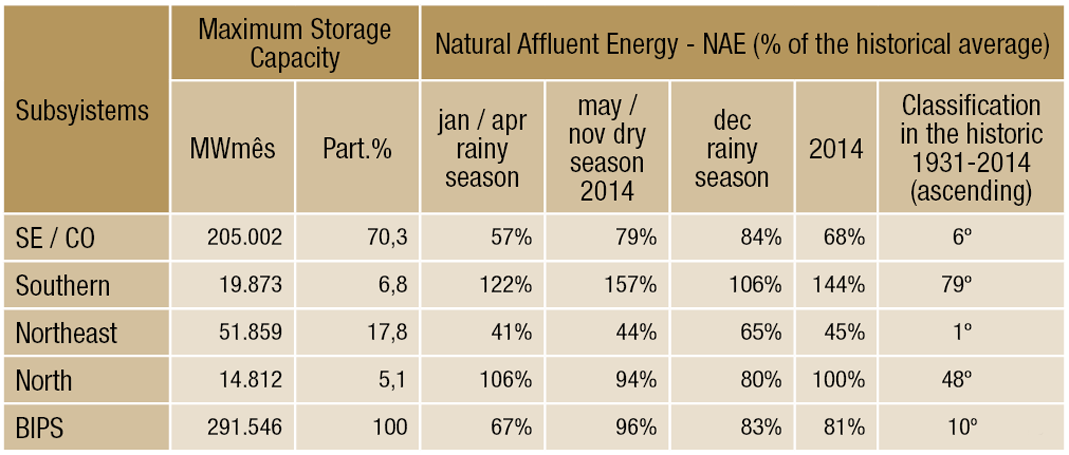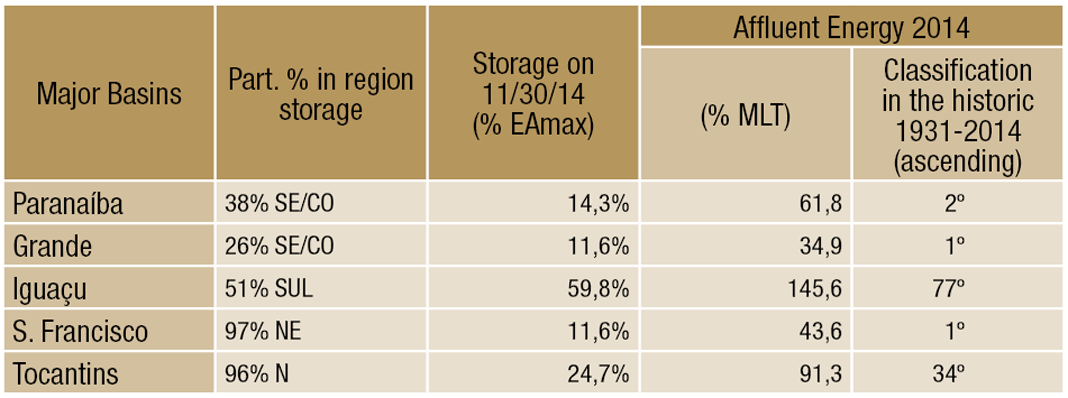
Technical Results in 2014
Energy Management Operation
Medium-Term Horizon
The Energy Operation Planning, each annual cycle, has two basic products. Monthly Future Cost Functions, determined by the medium-term optimization model (Newave), allow the connection of the medium-term operating strategies with the weekly political operation established in the Monthly Operation Program (PMO) using the short model term (Decomp). The second product is the Energy Operation Plan (PEN), whose main objective is to assess the conditions of the service provided to the market as a study horizon. Their results provide the Monitoring Committee of the Electricity Sector (CMSE) and the Energy Research Company (EPE) on the possible need for studies of expansion planning of generation and regional interconnections, to adjust the energy supply to guarantee criteria supply established by the National Energy Policy Council (CNPE). Exceptionally, in 2014, this study was issued in October.
The new energy aggregate by auctions and the addition of new transmission lines have increased energy supply in the period. The installed capacity of theBIPS should rise from 123,098 MW in 12/31/2013 to 159,420 MW in 12/31/2018. Hydroelectricity will remain the main source of power generation, although its share is reduced from 74.8% in 2014 to 70.9% in the end of the horizon.
There will be a significant increase in wind plantsinstalled capacity, which will rise from 1.9% of the electricity matrix (2,385 MW in December 2013) to 8.9%, equivalent to 11,852 MW installed at the end of 2018, without considering the next energy auctions that will add new supply until December 2018.
Again, there is a paradigm shift in how to opérate theBIPS, as pointed out by the Operator in several studies issued in recent years, due to the following aspects:
- Since the nineties hydropower plants with multi regulating reservoirs do not come into operation.
- As a result of this fact, the use of thermal generation has been more intense in recent years, even for hydrological years near long term average.
- Thermolectric generation has also been necessary to supplement the care provided to peak demand, both in summer and at the end of the dry season, due to the power loss by depletion in reservoirs.
- The continued expansion of transmission is of fundamental importance to the reduction of operating costs by allowing the importation and / or exportation of large blocks of power between regions, leveraging existing hydrological diversity between basins and / or regions.
- The start-up of major projects in the Amazon, at watermark wire, with pronounced seasonality, changes the energy supply available, with significant amounts of generation in the rainy season and low production in the dry season.
- A significant increase in wind generation over the next five years requires mitigating operational actions of potential systemic and local impacts caused by strong flashing of this new source in addition to its low predictability.
It is noteworthy that, due to the loss of regulating capacity of the system against load growth, has been increasing the influence of the initial conditions of storage on the results of the first two years of the evaluation horizon, impacting commonly metrics used in the energetic operation planning, as deficit risks, expected value of unserved energy and marginal operating costs.
The hydropower situation in 2014 is a clear example of the loss of regulation of the BIPS. Unfavorable weather conditions during the rainy season did not allow the recovery of stocks stored in the tanks of subsystems Southeast / Midwest and Northeast, even with full use of the thermal park. This resulted in much lower initial states of PEN 2014 storage than those typically used in previous editions of the energetic operation planning, with direct consequences on calculated deficit risks to the early years of the study horizon. In this context, careful interpretation of the results of the BIPS performance analysis, particularly with respect to energy deficit risks is important.
Also worth mentioning the analysis of meeting the peak demand for the of PEN 2014 baseline scenario, in which the tip balance indicates that the available net capacity planned for the period 2014-2018 is enough to fully meet the projected demand instant, including required operating reserve. Nevertheless, this evaluation observed depletion of hydro availability in the subsystems Southeast / Midwest, South and Northeast, requiring the use of the availability of thermoelectric sources, SHP, biomass and wind in all-round analysis.
In addition, bottlenecks were identified in the North-South interconnection, in a few months of the horizon, not allowing the transfer of water resources for other subsystems, confirming the diagnosis of energy assessments on the need to strengthen this interconnection.
The main PEN2014 recommendations are listed below:
- Effort in the sense of anticipation for 2016 of the transmission lines 500 kV Araraquara 2 - Itatiba and Araraquara 2 - Fernão Dias, in order to avoid possible congestion of energy generated in the Madeira Complex. Moreover, it is extremely important to maintain the schedule entry in the operating line at 500 kV Araraquara 2 - Taubate in July 2015.
- The results of the energy assessments indicate the need to develop economic feasibility studies to expand the capacity of the North-South interconnection and South-Southeast / Midwest, including the anticipation for the rainy season of 2017 of the 1st Bipole of Belo Monte’s plant's energy flow and the guarantee of implementation in terms of the structural solutions foreseen in the Expansion Planning.
- MME and ANEEL should evaluate the creation of regulatory mechanisms that encourage hydraulic power facility in theBIPS, either by the engine of existing wells in plants in operation, or by repowering existing plants or by the possibility of hiring power.
- The feasibility of conducting special auctions for power supply and region should be assessed by MME, particularly for South and Southeast / Midwestsubsystems, seeking to aggregate thermal generation, especially in the southern region of the country.
- New project technologiesshould be assessed by MME / EPE near to thermal plants manufacturers so that they may have greater flexibility in loading taking and resuming in order to cope with the participation of intermittent sources in the energy matrix.
- Minimum operating requirements on the use of intermittent unconventional renewable sources (wind and solar) should be required, not to compromise the operational safety of the BIPS in the occurrence of major systemic disturbance and / or local.
- A joint assessment with the CMSE and EPE / MME should be made as the definition of methodology adequate energy reserves, reserve generation thatshould be provided in the electricity matrix to face unfavorable weather events, such as experienced this year of 2014 for the subsystems Southeast / Midwest and Northeast. With the gradual loss of regulation and the increase of intermittent sources such as wind and solar future, similar situations may also require additional operative measures for the full cargo service with high costs for the consumer, even in hydrological years near historical average.
Short Term Horizon
Considering the BIPS as a whole, 2014 was a year below the historical average, with affluent energies in the order of 81% MLT. Analyzing subsystems separately it can be noted that the South and the North had higher inflows in the order of 144%and 100% of their historical averages, with lower values in other regions.
In the Southeastern / Midwestern regions, the rainy season, by the end of 2013, had a regular start, due to a neutral condition of the sea surface temperature in the equatorial Pacific. However, in January and February of 2014, the performance of a high pressure system inhibited the advance of cold fronts toward the region and the configuration of the South Atlantic Convergence Zone (SACZ), contributing to the occurrence of precipitation below average. In March and April, the weather systems operated with greater regularity in this region, but rainfall remained below average. Thus, the Southeast / Midwest region ended the year with inflows in the order of 68% MLT, ranking it as the sixth worst year history 1931-2014.
In the Northeastern region, almost throughout the year it prevailed a picture of unfavorable hydrological conditions - MLT 41% during the months of the rainy season and 44% MLT in the months of the dry season. The annual affluent energy stood at 45% MLT, ranking 2014 as the worst year of the historic 1931-2014.
Table 1 summarizes the conditions of inflows in 2014, showing that these were worse in exactly the sub tanks where there are more energy storage capacity.
Table 1 - Storage Capacity and Affluent Energy by Subsystem

Besides being characterized as a year of low inflows especially in the Southeastern / Midwestern and Northeastern, 2014 was an extremely adverse year for some river basins where are located the reservoirs with greater BIPS regularization capacity, as shown in Table 2.
Table 2 - Storage and Affluent Energy by Basin

As a result of these reduced inflows, the storage reservoir levels of the subsystems have suffered significant reductions in 2014, reaching the end of the year with values lower than those recorded in the previous year, according to Table 3 below.
Table 3 - Stored Energy by Subsystem

This delicate combination of low inflows and reduced storage levels in major reservoirs of the BIPS demanded from ONS, while preparing the Monthly Operation Programs and its weekly reviews, a careful management of the available hydropower resources, with the implementation of operative measures among which stand out the preservation of the headboard storage tanks of the major river basins, the full availability of the dispatch of thermoelectric plants and the use of power transmission capacity to carry out transfers from regions with higher energy availability, north and south, to the worse off, northeastern and Southeastern / Midwestern regions.
Also, the easing of some of the main hydraulic constraints of the the BIPS had great importance for ensuring service electro-energetic in 2014, which resulted from the coordination and joint work between ONS, regulatory agencies ANA and ANEEL, IBAMA, MME, MMA, the basin committees and sector agents, to match the energy requirements with those associated with the multiple uses of water, especially:
- Waterway Navigation Minimum levels of Tietê / Paraná to the downstream section of Nova Avanhandava plant;
- Minimum flowing down of Três Marias, Sobradinho, Xingó, Jupiá, Porto Primavera, Caconde and the dam of Santa Cecilia plants;
- Minimum Generation of the hydroelectric plants generating units during light load periods;
- Itaipu plant operation as regulating reservoir, between the maximum level of 220.40 m to 216.00 m minimum; and
- Minimum storage in Mascarenhas de Moraes hydroelectric plant (75% of its working volume) to capture water and ferry crossing the reservoir.
© 2015 ONS - All rights reserved
© 2015 ONS - Todos os direitos reservados